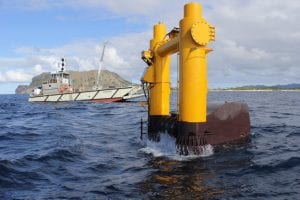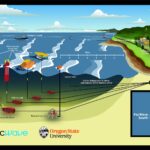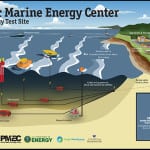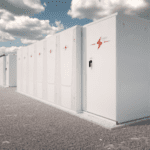The U.S. Department of Energy (DOE) has announced it will provide as much as $27 million in federal funding for research and development projects designed to advance the efficient conversion of wave-based energy into electricity, with a goal to make the technology commercially viable.
The DOE on July 7 said the money supports the Biden administration’s efforts “to build a clean energy economy,” along with the president’s target of net-zero carbon emissions from the power sector by 2050.
The agency on Wednesday said projects selected for the funding will undertake their research at the PacWave South facility, located off the coast of Oregon, near Newport. Construction of PacWave South, supported by grants from the DOE and the state of Oregon, among others, began in June. Officials expect the site will be operational in 2023.

“Oregon is helping lead the nation in our efforts to harness the unlimited energy potential in America’s oceans and lakes,” said Energy Secretary Jennifer Granholm on Wednesday. “With wave energy, we have the opportunity to add more renewable power to the grid and deploy more sustainable energy to hard-to-reach communities. DOE’s investments in America’s businesses and universities developing these new technologies will propel our clean energy future.”
Wave energy is a form of marine energy that is captured when wind blows over the surface of open water in oceans and lakes. A wave energy converter (WEC) is needed to convert the captured energy into electricity.
European Efforts
Wave energy technologies are being studied by other countries, including in Europe. The UK in March announced £7.5 million ($10.37 million) of public funding would be used to support the development of eight wave energy projects, with research and development led by UK educational institutions.
SIMEC Atlantis Energy in April said it would seek UK government support for an expansion of what it called the world’s largest tidal energy project, the MeyGen installation off Scotland’s northern coast.
Mocean Energy, headquartered in Edinburgh, Scotland, recently announced its Blue X wave machine had begun testing at the European Marine Energy Centre in Orkney, an archipelago north of mainland Scotland. The Blue X wave machine is 20 meters long, and weighs 38 metric tons.
Ocean Energy Europe earlier in 2021 said about 260 kW of tidal stream capacity was added in Europe last year, with 200 kW of wave energy installed. The group last month said there are “more than enough ocean energy projects in the works” to meet the European Offshore Renewable Energy Strategy’s target of 100 MW of installed capacity by 2025. The group said there are “17 major projects … already in progress, representing over 160 MW of clean energy and €1.2bn [$1.42 billion] of investment.”
Challenges for Testing and Deployment
Testing marine-energy technologies in the open ocean has been challenging due to issues with permitting, along with a lack of available test sites. The DOE in 2016 DOE partnered with Oregon State University to build PacWave South, which the agency said “is the nation’s first accredited, grid-connected, pre-permitted, open-water wave energy test facility.”
Wednesday’s funding opportunity announcement (FOA) is for testing and R&D activities in the “Advancing Wave Energy Technologies through Open Water Testing at PacWave” program. It will support the first round of projects at PacWave South.
Watch this video of the Azura Wave Energy device during its deployment off the Hawaiian coast.
Work performed under this FOA “also will produce open-access data that will benefit the entire WEC R&D community,” according to DOE’s announcement. The agency said data will include wave, wind, and ocean current resource measurements, geotechnical measurements, and environmental monitoring measurements “that will help improve future WEC system designs for PacWave and reduce the costs of future deployments.”
“The ocean covers more than 70% of the surface of our planet, and we can capture the power of its waves, currents, and tides to help power our homes, buildings, and communities,” said Suzanne Bonamici, an Oregon representative in the U.S. House. “As we transition to a 100% clean energy economy, marine energy has tremendous potential as one of the last untapped renewable energy sources. Federal investment will help unlock it. This funding for research, development, and demonstration efforts at the PacWave testing facility will catalyze this promising industry and build on the innovation of Oregon State researchers and Oregon employers.”
Specific Topic Areas
The research at PacWave South will look at technologies and processes to more efficiently convert wave energy into electricity, and also at the integration of such renewable power to the grid. It also will look at other “blue economy” markets. The DOE specifically said funding will support projects focused on:
Testing WEC Technologies at PacWave (up to $15 million in federal funding): This topic area focuses on testing of WEC system designs intended for remote and microgrid applications, as well as open-source WEC systems that aim to generate publicly available data and knowledge to benefit the entire WEC industry.
Advancing WEC Designs for PacWave (up to $5 million in federal funding): This area will support the development of designs of robust WEC systems to generate off-grid or grid-connected power. By the end of the award period, the systems designed would be ready for fabrication, deployment, and prototype testing at PacWave South.
Open Topic: Wave Energy R&D at PacWave (up to $7 million in federal funding): This area will directly leverage the PacWave test facility to perform impactful wave energy R&D that will advance the marine energy industry as a whole. This topic area will support projects that advance WEC systems, system components, environmental monitoring technologies, instrumentation and prognostic health monitoring systems, wave measurement systems, and other supporting technologies.
The DOE said concept papers for the FOA are due August 13, and full applications are due October 5. An informational webinar will take place July 22; full details of the announcement can be found at this DOE website.
—Darrell Proctor is a senior associate editor for POWER (@POWERmagazine).










